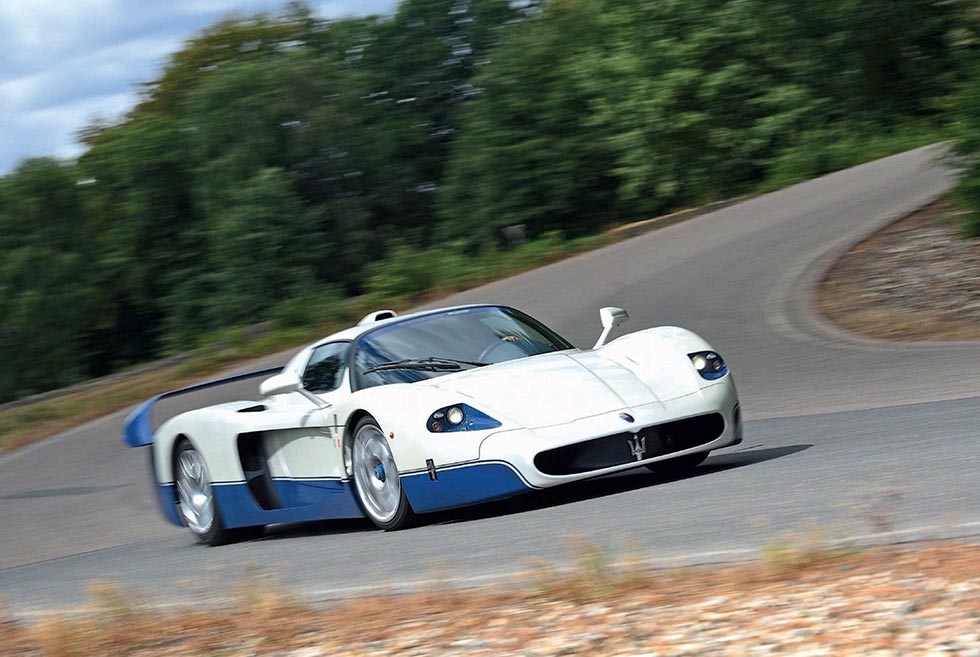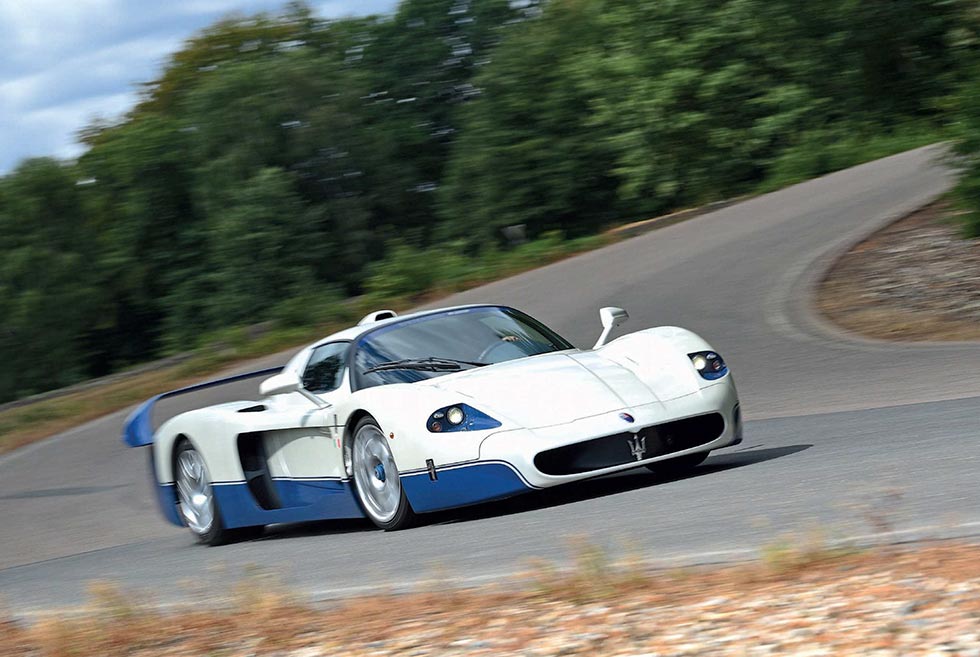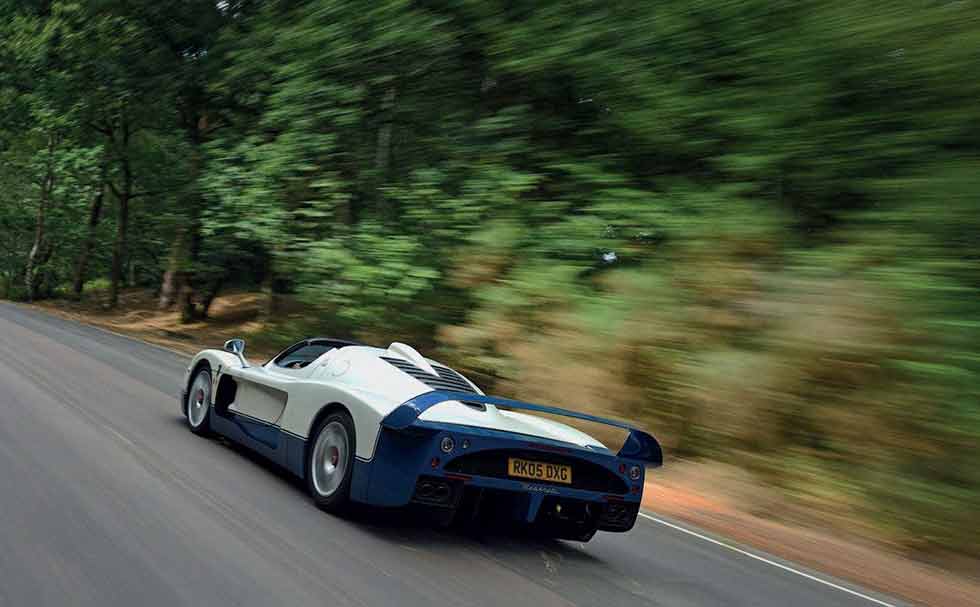
Isn’t it time Maserati’s MC12 emerged from the shadow of its Ferrari sibling? It was more Maranello than Bologna under the skin, but the MC12 returned ailing Maserati to racing glory. Words Greg Macleman Photography Neil Williams.
THE ENZO’S NEW CLOTHES? UNSUNG WORLD-BEATER
‘Not a car you would ever describe as pretty, the MC12 has a certain something beyond the obvious brutish machismo of a roadgoing GT1’

The summer sun was high in the sky, beating relentlessly down on a baked Kyalami circuit. The mercury had hit 90ºF and the jet-black asphalt was sucking up the heat like a sponge, reaching at points a tyre-destroying 140ºF as choking clouds of cement dust – laid down to mop up an earlier oil spill – wreathed the track. Soaring temperatures, coupled with the 5000m altitude of the circuit, wreaked havoc with the field. Fuel boiled in pumps and cars spluttered and struggled, while the steed of Pedro Rodríguez began to exhibit gearbox problems. Things weren’t looking great for the Maserati-engined Coopers. The 1967 South African Grand Prix became a war of attrition, brutal conditions contributing to the destruction of Dan Gurney, Jim Clark and Jackie Stewart’s engines, plus the Maserati unit of Jochen Rindt, and by the chequered flag more drivers had retired than finished. Even race leader Jack Brabham was put out of contention, leaving a three-way battle for victory between Rhodesian John Love, Rodríguez and John Surtees, whose feet were badly blistered from the red-hot pedals of his Honda RA300. By the closing laps, a misfire from Love’s Cooper- Climax caused an excessive thirst, and with six laps to go he came in for just two gallons of fuel – allowing the wounded Cooper-Maserati of Rodríguez to limp into the lead, always seeming to be in a gear either too high or too low. As the Mexican crossed the line, he bookended a competition history that began in 1926 when Alfieri Maserati finished first in class in a dust and oil-streaked Tipo 26 at the Targa Florio, and ended in South Africa with the firm’s final championship win of the 20th century.

‘Another flick of the paddle into third gear and where a normal car would begin to feel the strain, the Maserati just powers on’
That the Trident’s next assault on the world of top-flight motorsport didn’t come until the turn of the millennium should come as little surprise, given the firm’s torrid financial situation in the decades that followed the win at Kyalami. The Orsi family abandoned the project in 1968, leading to an era of turmoil with Citroën then De Tomaso, and by the 1990s the company was on life support, kept afloat by the constant but waning drip of government assistance. By 1994, the firm had burned through 400 billion Lira of the people’s money. It wasn’t until near neighbour Ferrari got involved in 1997, following a brief period of ownership by parent company Fiat, that Maserati began to stabilise, and finally be in a position where the production of top-quality road cars – and maybe even a return to racing – became a realistic possibility. Under Ferrari stewardship the last vestiges of De Tomaso’s influence were wiped away as the 3200GT gave way to the Coupé and Spyder – but attention quickly turned to the track, and the opportunity to create a halo car worthy of such close association with the Prancing Horse.
Work began on the new Maserati, codenamed MCC, as early as May 2002, with the ultimate aim to create 50 roadgoing cars to homologate the model for racing. It relied heavily on the technology and engineering know-how underpinning the flagship Enzo Ferrari. Its Modena stablemate donated a number of vital components to the cause, starting with its monocoque chassis – a lightweight carbon and flame-resistant Nomex honeycomb sandwich – which was paired with weight-saving aluminium subframes front and rear. At its heart was the Enzo’s 5998cc 65º quad-cam V12 engine, which shared the 104mm bore spacing with the Quattroporte’s jointly developed ‘Ferrari-Maserati’ V8 and imbued the new GT with a power output of 621bhp. Eagle-eyed tifosi will note the 30bhp shortfall compared with the Enzo, the result of the Maserati version being limited to just 7700rpm. The timing was remapped, while the camshafts went from being chain- to gear-driven. Maserati engineers also cannibalised the Ferrari’s six-speed electro-hydraulic semi-automatic gearbox – operated by two steering column-mounted paddles and said to swap cogs in just 150 milliseconds. And when Sport mode wasn’t enough, a button labelled ‘Race’ relaxed the ASR (which helps control wheelspin) and sped up the gearchange. An area where the two cars differed to a further degree was suspension, with the Maserati opting for double wishbones and pushrod-operated springing with conventional dampers, instead of the Ferrari’s active damper system, though the ability to raise the nose for speed bumps at the push of a button – even more vital with the long-nosed MC12 than with the Enzo – remained.
Considering the scale of the task facing Maserati engineers the project moved at pace, and by September 2002 – just five months after work began – the styling buck was ready. It’s clear that designer Frank Stephenson, who counted among his successes the BMW X5, was a busy man throughout. For a start, there’s the sheer size of the thing; it’s taller, wider and longer than the Enzo, with over two inches added to roof and waist, and a whopping 17.4 inches fore and aft. Where the Enzo is svelte and lithe the Maserati is less gainly, with most of the extra length added to the nose and tail to create mammoth overhangs that, combined with a monstrous rear wing, produced greater down-force than the Enzo. And while the two cars might have been blood brothers beneath the skin, externally they differed wildly, sharing only a windscreen – but the two designs are so strikingly dissimilar you’d do well to notice.
Not a car that you would ever describe as pretty, the MC12 nonetheless has a certain something beyond the obvious brutish machismo of a roadgoing GT1 car. Unlike the angular Enzo, the front of the Maserati is much more organic, with flowing lines and an attractive wide mouth, and a bonnet pierced by deep, curvaceous vents that cast intriguing shadows on the bright summer’s day of our photoshoot. The back of the car – where the rear window ought to be – again brings to mind shapes of nature, while the slab-backed tail is altogether more workmanlike. The lights, too, seem an afterthought, with the headlamps lacking fairings and the rears looking like something ordered from the back pages of Max Power, somewhere between the Cherry Bomb exhausts and premium-rate lonely housewife hotlines.
For all its challenging features, nothing quite prepares you for the sight of one on the road, and we’re more than a little surprised to discover that Alex Babbington has cancelled the expected car transporter and driven the Maserati to our photoshoot, battling London traffic from Joe Macari’s Wimbledon base to our test track 25 miles away. Top marks all round, but any illusions that Maserati’s MC12 is in fact a usable road car are dispelled as its occupants spill out onto the hardstanding on all fours á la Wolf of Wall Street – hindered slightly by the more conventional hinged doors, where the Enzo uses a butterfly arrangement.
Climbing in is easier, and with a bit of care you slip comfortably into a blue leather-trimmed carbonfibre bucket, on the left-hand side of the car. Period testers reckoned the cabin was luxurious by supercar standards, but I’ve either not been exposed to enough of them or have a keener eye for race-car compromises; notably the thick scaffold-pole rollover hoop and solid firewall preventing any view out of the back. It feels more racer than grand tourer, even before the key is turned and blue start button pressed. When it is, the cabin fills with the mechanical noise of chains and pulleys, the more sonorous engine notes muffled by the firewall leaving just the sound of an angry cement mixer – there are no piped-in aural enhancements here.
In a lifetime of driving, the maxim mirror, signal, manoeuvre has never felt more important; two door mirrors provide the only rearward view, leaving a vast blind-spot directly behind the car, which feels absurdly wide. Even on a closed circuit there’s cause to be cautious – a McLaren Senna howls by as we pull back on the right paddle and select first. Being semi-automatic, there are only two pedals and the response to planting the throttle is immediate, necessitating another flick of the paddle as the needle shoots across the tachometer at an alarming rate. Now third, and where a normal car would begin to slow and feel the strain, the Maserati powers on – at each change you’re nearly caught out by the rev limiter, and by fifth gear the MC12 is tearing along the straight at breakneck speed. It feels more like a Group-C-car on the Mulsanne than a road-legal GT, though the 12-cylinder howl that is such a treat trackside becomes distorted from within, the cabin resonating to every bang and clatter from the rough road surface and the purposeful yet gruff roar from the rear.
It seems absurd to say that a 621bhp supercar capable of 205mph and 0-60mph in 3.8 secs could seem deceptively quick, but it is. Short-shifting to third in preparation for a low-speed corner feels restrained until you reach the bend and a quick glance at the speedo shows 60mph and climbing, forcing you to hit the anchors. The Maser lacks the ceramic discs of its Ferrari brother – one of a number of areas where the Trident-badged car falls slightly short – but the cross-drilled steel Brembo rotors (bigger than the wheels of the Ford Ka in which we arrived) still pull up with enough force to throttle the unexpecting with their four-point harnesses. Now it’s time to see what this car can really do.
Shifting up through the gears becomes smoother with speed, as does the engine, which is less comfortable at low revs. But the gearchange feels slower than the spec sheet suggests and unsettles the car in bends, bringing the rear-biased 41:59 weight distribution into stark relief. Swap cogs before a corner, though, and you’ll be shocked at the Maserati’s ability to hold its line – body roll is near non-existent, only the clatter of long-lost pocket change scattering across the carbonfibre tub giving away the lateral forces involved.
Your awareness of the car’s size melts away while threading together a sinuous set of turns and again the Maserati turns GT1 racer, the curved windscreen and slashed louvres of the front wings providing a brilliant view ahead and inspiring confidence to place the nose into corners. You could carry on all day; sadly, time is called on the session just as the car gets into its stride. And while it’s difficult to imagine popping to the shops, driving it to work – or even facing the insurmountable obstacle of a sleeping policeman – out on a clear track it is magnificent.
The Maserati MC12 is a car that confused people when it first broke cover in 2004. They couldn’t see the logic in buying a rebodied car that was in almost every way inferior to the machine on which it was based, from having less advanced suspension and inferior brakes, to boasting less power and a lower top speed. Most damning of all was the combination of poor usability due to the lack of rear window and a crippling price-tag that put it right up there with the most expensive cars in the world.
Is the MC12 greater than the sum of its parts? Probably not. Choosing one over an Enzo the first time round could only be described as a crime of passion – and with values now approaching £2.5m, the same is even more true today. But sometimes, you just have to forget your head and follow your heart.
Thanks to Joe Macari (020 8870 9007; www.joemacari.com)
DESTINED FOR THE TRACK
The MC12 road car was only ever a ticket to endurance racing for Maserati, and as soon as the 25 required Stradales were built, the factory-backed AF Corse stable was let loose on the FIA GT Championship. But fears that the car would prove too dominant, as with the Mercedes-Benz CLK GTR back in the ’90s, delayed homologation approval until late in the season.
By 2005 the car had been cleared, and the Maseratis duly swept aside all competition, winning the constructors’ title with 239 points – almost doubling Ferrari’s tally.

MC12s carried the champion drivers from 2006-’2009, as well as scoring a win in the inaugural FIA GT1 World Championship in 2010 (right).
Maserati also had difficulty getting the green light to race in the American Le Mans Series due to the MC12 exceeding length and width restrictions. In 2005, the governing body allowed it to run – but not to score points – and the single Risi Competizione car failed to make an impression, crashing out of the season finale at Laguna Seca.
Following the GT1’s on-track success, a strictly track-only version of the MC12 was created for customers with deep pockets. Owners of the 12 ‘Corsa’ versions, priced at €1m each and finished in the firm’s Blue Victory hue, were only allowed to drive the cars during sanctioned track days. Based on the GT1, these variants produced 745bhp.
Tech and photos
MASERATI MC12 STRADALE
Sold/number built 2004-’2005/50
Construction stress-bearing, carbonfibre and Nomex honeycomb sandwich monocoque, front and rear aluminium subframes
Engine all-alloy, dohc-per-bank, dry-sump 5998cc V12, multi-point fuel injection
Max power 621bhp @ 7500rpm
Max torque 481lb ft @ 5500rpm
Transmission six-speed, paddle-shift semi-automatic transaxle, RWD
Suspension independent by double wishbones, with pushrod-operated coil springs over dampers front and rear
Steering power-assisted rack and pinion
Brakes cross-drilled discs all round, 14.96in (380mm) front, 12.18in (335mm) rear
Length 16ft 10 ½ in (5143mm)
Width 7ft 10 ½ in (2096mm)
Height 3ft 11 ½ in (1205mm)
Wheelbase 9ft 2in (2800mm)
Weight 2943lb (1335kg)
0-60mph 3.8 secs
Top speed 205mph
Mpg 12.3
Price new £560,000
Price now £2.5m
‘By fifth gear, the MC12 is tearing along at breakneck speed. It feels more like a Group C car on the Mulsanne than a road-legal GT’
‘Unlike the angular Enzo, the front of the Maserati is much more organic, with flowing lines and an attractive wide mouth’
‘Not a car you would ever describe as pretty, the MC12 has a certain something beyond the obvious brutish machismo of a roadgoing GT1’
Subtlety has no place: the strakes of deep nose vents add aggression to Maserati’s appearance. Blue leather dominates an interior compromised by the model’s race breeding. Top: door mirrors offer only rearward view, ensuring a big blindspot. Maserati MC12 was driven to our shoot rather than transported by trailer, but there is little that is practical about a supercar built to win motor races. Conventional doors mean that the roof can come off for wind-in-the-hair fun – large air scoop feeds the ravenous 5998cc V12. Front and rear overhangs make MC12 17.4in longer than its Enzo sibling. Below: the 621bhp V12 is 30bhp short of the same engine in the Ferrari.






